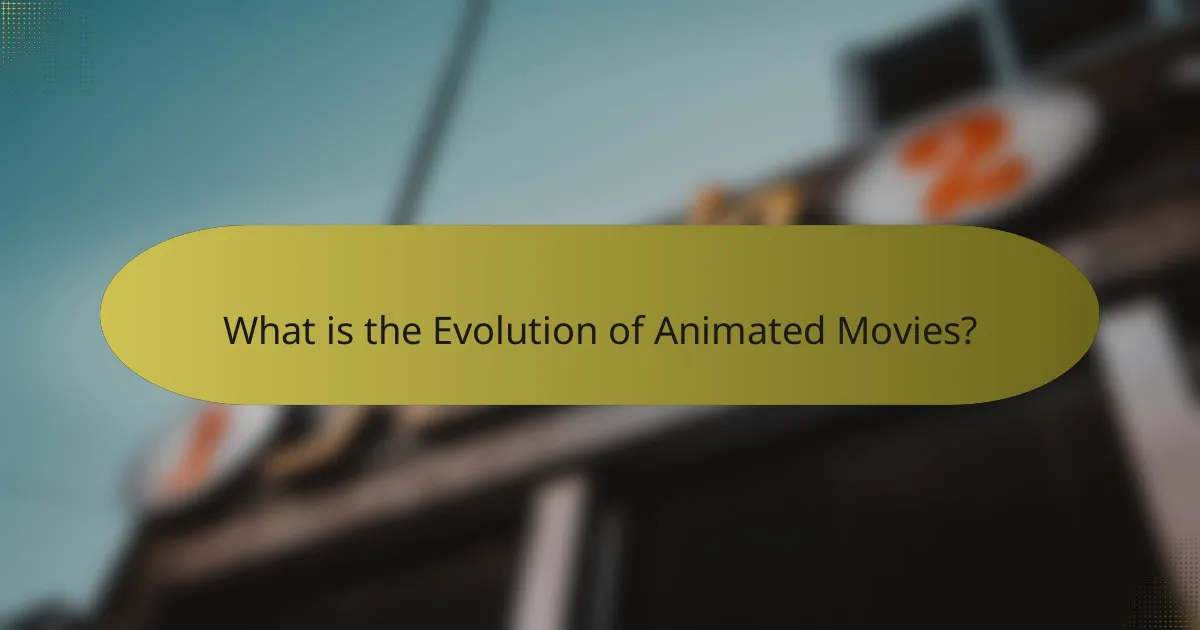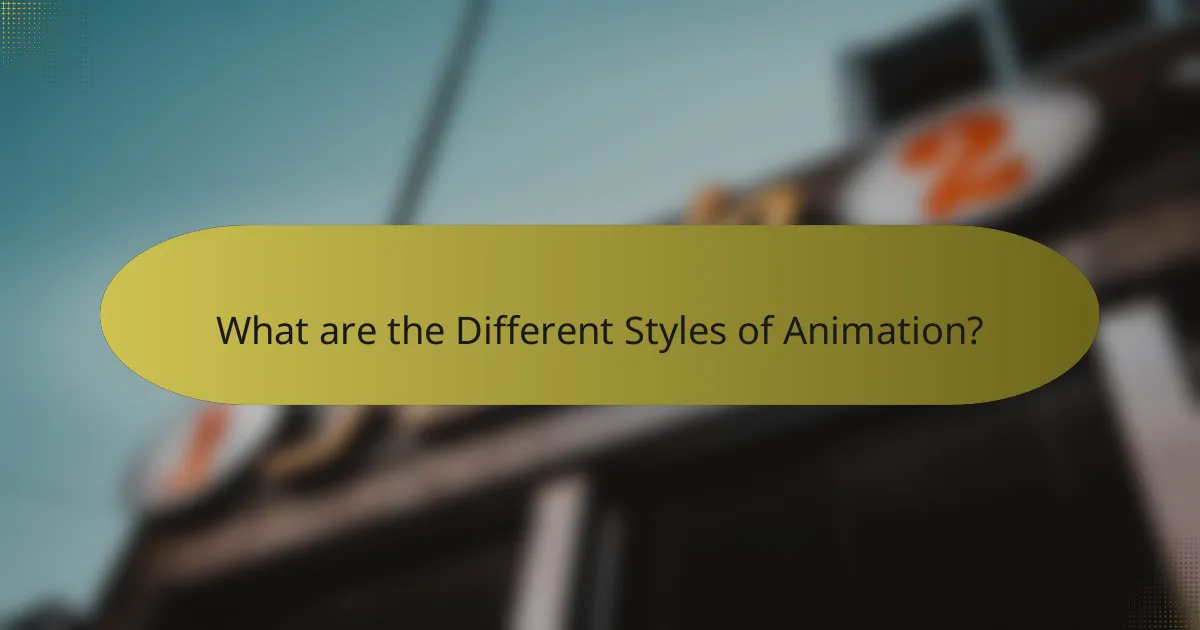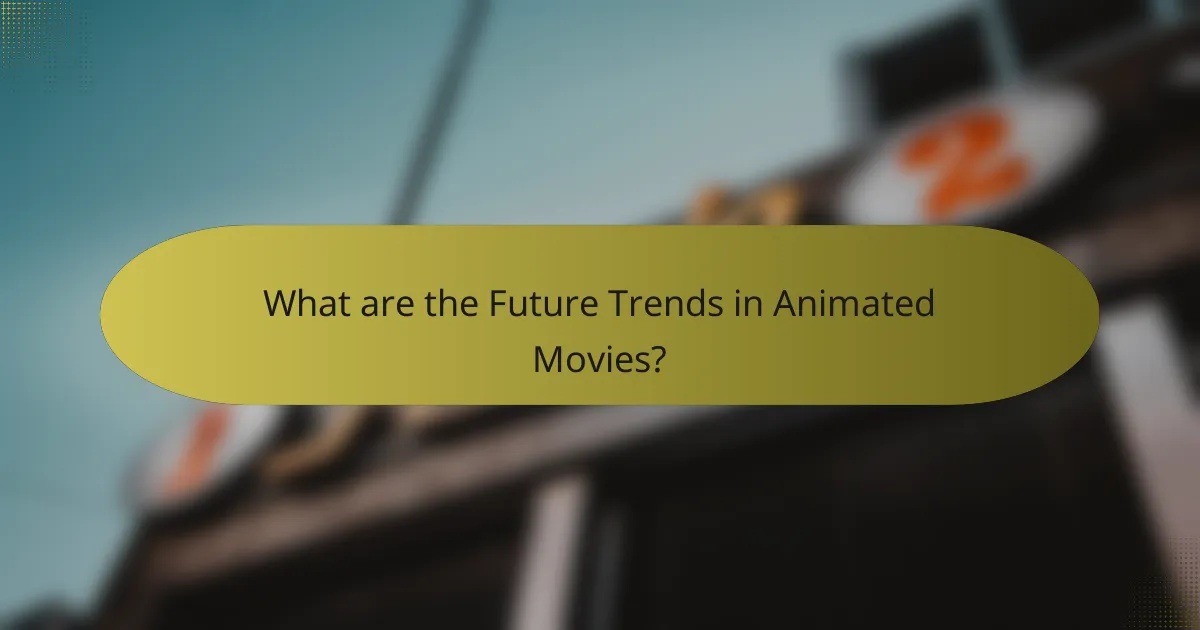The article explores the evolution of animated movies from their inception in the early 20th century to the present day. It highlights key milestones, such as the release of “Humorous Phases of Funny Faces” in 1906, the introduction of synchronized sound with “Steamboat Willie” in the 1920s, and the emergence of full-length features like Disney’s “Snow White and the Seven Dwarfs” in 1937. Various animation styles are discussed, including traditional, 3D, stop-motion, and motion graphics, each with unique characteristics. The article also examines future trends in the animation industry, such as the integration of artificial intelligence, virtual reality experiences, diverse storytelling, sustainable production practices, and the impact of streaming platforms on distribution.

What is the Evolution of Animated Movies?
The evolution of animated movies began in the early 20th century with short films. In 1906, “Humorous Phases of Funny Faces” marked one of the first animated films. The 1920s saw the introduction of synchronized sound with “Steamboat Willie,” featuring Mickey Mouse. The 1930s brought full-length animated features, starting with Disney’s “Snow White and the Seven Dwarfs” in 1937. The 1960s and 70s introduced more diverse styles, including [censured]-oriented animation like “Fritz the Cat.” The 1990s popularized CGI animation, exemplified by Pixar’s “Toy Story.” The 2000s and beyond saw advancements in technology, leading to hyper-realistic animations. Today, animated movies encompass various genres and styles, appealing to both children and adults.
How have animated movies changed over the decades?
Animated movies have evolved significantly over the decades. In the early 20th century, animation was primarily a novelty. Short films like “Steamboat Willie” in 1928 showcased synchronized sound. The 1930s introduced full-length features, such as “Snow White and the Seven Dwarfs,” which set a new standard. The 1960s and 1970s saw the rise of television animation, with shows like “The Flintstones.” The 1990s marked a renaissance with CGI technology, exemplified by “Toy Story” in 1995. Today, animated films blend various techniques, including 2D, 3D, and stop-motion. The storytelling has become more complex, appealing to both children and adults. Overall, animated movies have transitioned from simple shorts to sophisticated narratives with diverse themes.
What technological advancements have influenced animated films?
Technological advancements have significantly influenced animated films. The introduction of computer-generated imagery (CGI) revolutionized animation in the 1990s. Films like “Toy Story,” released in 1995, showcased the potential of 3D animation. Advancements in software, such as Autodesk Maya and Blender, have enabled more complex and realistic animations. Motion capture technology has also enhanced character movements, providing a lifelike quality. High-definition displays improved the visual experience for audiences. Streaming platforms have changed distribution methods, allowing for wider access to animated films. These advancements collectively shaped the evolution of the animation industry.
How has storytelling evolved in animated movies?
Storytelling in animated movies has evolved significantly over the decades. Early animated films focused primarily on simple narratives and visual gags. For instance, Disney’s “Snow White and the Seven Dwarfs” introduced emotional depth and character development in 1937. The 1990s saw the rise of complex stories with themes of identity and belonging, exemplified by “The Lion King.”
Technological advancements have also influenced storytelling. Computer-generated imagery (CGI) allowed for more intricate visual storytelling, as seen in Pixar’s “Toy Story” in 1995. Modern animated films now incorporate diverse narratives that reflect global cultures and social issues.
Additionally, there is a trend towards blending genres and targeting older audiences. Films like “Spider-Man: Into the Spider-Verse” showcase innovative storytelling techniques and unique visual styles. Overall, storytelling in animated movies has become richer and more varied, appealing to a broader audience.
What are the key milestones in the history of animated movies?
The key milestones in the history of animated movies include several significant developments. In 1906, “Humorous Phases of Funny Faces” became one of the first animated films. In 1928, Walt Disney released “Steamboat Willie,” the first synchronized sound cartoon. The introduction of Technicolor in 1932 marked a major advancement, showcased in Disney’s “Flowers and Trees.” In 1937, Disney’s “Snow White and the Seven Dwarfs” debuted as the first feature-length animated film. The 1960s saw the rise of television animation, with shows like “The Flintstones.” In 1995, Pixar released “Toy Story,” the first entirely computer-generated feature film. The 2000s introduced advancements in 3D animation, with films like “Shrek” and “Finding Nemo.” Each of these milestones contributed significantly to the evolution of animated movies.
Which animated films marked significant turning points?
“Snow White and the Seven Dwarfs” marked a significant turning point in animated films as it was the first full-length cel-animated feature. Released in 1937, it established animation as a viable medium for storytelling. “The Lion King,” released in 1994, revolutionized the industry with its use of computer-generated imagery alongside traditional animation. It became one of the highest-grossing animated films of all time. “Toy Story,” released in 1995, was the first entirely computer-animated feature film. It set new standards for animation technology and storytelling. “Frozen,” released in 2013, showcased the power of musical storytelling in animated films, becoming a cultural phenomenon. These films collectively transformed the landscape of animation, influencing future productions and audiences.
What role did studios play in shaping the animation industry?
Studios played a crucial role in shaping the animation industry by establishing production standards and creative practices. They pioneered techniques such as cel animation and computer-generated imagery. For instance, Walt Disney Studios introduced synchronized sound in animation with “Steamboat Willie” in 1928. This innovation set a benchmark for future animated films. Additionally, studios influenced storytelling methods, creating iconic characters and narratives that resonated with audiences. The success of franchises like “Toy Story” by Pixar demonstrated the potential of animated features at the box office. Overall, studios have been instrumental in advancing technology and artistry in animation, defining the industry’s evolution.
How do cultural influences impact animated movies?
Cultural influences significantly impact animated movies by shaping their themes, characters, and storytelling techniques. These influences reflect societal values and norms. For example, Disney’s “Mulan” incorporates Chinese culture, emphasizing honor and family loyalty. Similarly, Studio Ghibli films often draw on Japanese folklore and environmental themes. Cultural context informs humor and emotional resonance in animation. In addition, animated films can serve as a medium for cultural exchange, introducing audiences to different traditions and perspectives. This cross-cultural representation fosters global understanding and appreciation. The success of animated movies often hinges on their ability to resonate with cultural identities.
What themes reflect societal changes in animated films?
Animated films reflect societal changes through themes such as diversity, environmentalism, and gender roles. These themes illustrate evolving cultural values and social issues. For instance, films like “Zootopia” address racial and social stereotypes. “Wall-E” highlights environmental concerns and the impact of consumerism. Additionally, movies like “Frozen” challenge traditional gender roles by showcasing female empowerment. The representation of [censured] characters in films like “Onward” signifies a shift towards inclusivity. Historical context shows that animated films often mirror the societal climate of their release periods. For example, post-9/11 films like “The Incredibles” reflect themes of heroism and family unity. These examples demonstrate how animated films serve as a lens for societal change and cultural reflection.
How do different cultures interpret animation styles?
Different cultures interpret animation styles based on their unique artistic traditions and societal values. For instance, Japanese anime often emphasizes emotional depth and stylized visuals, reflecting cultural narratives and aesthetics. In contrast, Western animation typically prioritizes humor and broad appeal, as seen in Disney films that focus on family-friendly themes.
Cultural context shapes the themes and character designs in animation. For example, African animations may incorporate local folklore and vibrant colors, representing cultural heritage. Studies indicate that animation can serve as a medium for cultural exchange, allowing diverse interpretations and adaptations.
Research highlights that animation styles resonate differently with audiences, influenced by cultural backgrounds. The diversity in animation interpretation showcases the richness of global artistic expression.

What are the Different Styles of Animation?
The different styles of animation include traditional animation, 3D animation, stop-motion animation, and motion graphics. Traditional animation involves hand-drawn images, often on paper. This style was dominant from the early 20th century until the 1990s. 3D animation uses computer-generated imagery to create lifelike characters and environments. This style gained popularity in the late 1990s with films like “Toy Story.” Stop-motion animation involves photographing physical objects in incremental movements. This technique has been used in films such as “The Nightmare Before Christmas.” Motion graphics combine graphic design with animation techniques. This style is commonly used in advertisements and title sequences. Each style has distinct characteristics and applications in the animation industry.
What are the major types of animation techniques?
The major types of animation techniques include traditional animation, 2D vector-based animation, 3D computer animation, stop-motion animation, and motion graphics. Traditional animation involves hand-drawn images on transparent sheets. This technique has been used since the early 20th century. 2D vector-based animation utilizes digital tools to create animations using vector graphics. It became popular with the rise of computer technology. 3D computer animation uses software to create three-dimensional objects and environments. This technique revolutionized the animation industry in the 1990s. Stop-motion animation involves photographing physical objects in small increments to create movement. It has been used in films like “The Nightmare Before Christmas.” Motion graphics combine animated graphic design elements to convey messages. This technique is widely used in advertisements and title sequences. Each of these techniques has contributed to the evolution of animated movies over the decades.
How does traditional animation differ from digital animation?
Traditional animation involves creating images by hand-drawing or painting on physical media. Each frame is crafted individually, resulting in a fluid movement when played in sequence. Digital animation, on the other hand, utilizes computer software to create images and animations. It allows for easier manipulation of characters and backgrounds. Traditional animation often requires more time and labor due to the manual process. Digital animation can streamline production with tools that automate certain aspects. Historical examples include Disney’s “Snow White” (1937) for traditional animation and Pixar’s “Toy Story” (1995) as a pioneer of digital animation.
What are the characteristics of stop-motion animation?
Stop-motion animation is characterized by its frame-by-frame technique. This method involves photographing physical objects in incremental movements. Each frame is captured individually, creating the illusion of motion when played in sequence. Common materials used include clay, puppets, and everyday objects. The process requires meticulous planning and attention to detail. It often involves intricate sets and lighting setups. The animation style can evoke a unique aesthetic, often described as tactile and organic. Historical examples include “The Nightmare Before Christmas” and “Wallace & Gromit,” showcasing the art form’s versatility.
How do animation styles evolve with technology?
Animation styles evolve with technology through advancements in tools and techniques. Early animation relied on hand-drawn frames and physical media. The introduction of computer-generated imagery (CGI) in the 1990s revolutionized the field. For example, Pixar’s “Toy Story” was the first fully CGI feature film, showcasing new possibilities. As software improved, animators gained access to more sophisticated rendering capabilities. This led to more realistic textures and movements in animated films. Additionally, motion capture technology allowed for lifelike character animations. Innovations in virtual reality and augmented reality are now creating immersive experiences. Each technological leap has influenced the aesthetic and narrative possibilities of animation.
What innovations have transformed animation production?
Innovations that have transformed animation production include computer-generated imagery (CGI), motion capture technology, and real-time rendering. CGI revolutionized the industry by allowing for more complex and visually stunning animations. Movies like “Toy Story” showcased the potential of CGI in feature films. Motion capture technology enabled animators to create lifelike movements by capturing the performances of real actors. This technique was prominently used in films like “Avatar.” Real-time rendering has further enhanced production efficiency, allowing animators to see changes instantly during the creative process. The integration of virtual reality (VR) and augmented reality (AR) also opened new avenues for storytelling and viewer engagement. These innovations collectively reshaped how animated content is created and experienced.
How has CGI changed the landscape of animated films?
CGI has fundamentally transformed the landscape of animated films. It has enabled the creation of more realistic and visually stunning imagery. Traditional animation techniques often limited the complexity of visual storytelling. CGI allows for intricate details and lifelike movements that were previously unattainable. For example, Pixar’s “Toy Story” was the first entirely computer-animated feature film, released in 1995. This marked a significant shift in animation technology and storytelling. CGI has also facilitated the blending of live-action and animation, as seen in films like “Who Framed Roger Rabbit?” and “The Lion King.” The industry now embraces CGI for its versatility in various genres and styles. As a result, CGI has become the standard for animated films, influencing both production techniques and audience expectations.

What are the Future Trends in Animated Movies?
Future trends in animated movies include increased use of artificial intelligence. AI is streamlining animation processes and enhancing creativity. Another trend is the rise of virtual reality experiences. These immersive formats allow audiences to engage interactively with stories. Additionally, diverse storytelling is becoming more prevalent. Animated films are exploring various cultures and perspectives. Sustainability in production is also gaining traction. Studios are adopting eco-friendly practices and materials. Finally, streaming platforms are reshaping distribution models. They provide easier access to a wider range of animated content. These trends indicate a dynamic evolution in the animated film industry.
What emerging technologies are shaping the future of animation?
Emerging technologies shaping the future of animation include virtual reality (VR), augmented reality (AR), and artificial intelligence (AI). VR creates immersive experiences, allowing viewers to engage with animations in three-dimensional spaces. AR overlays digital content onto the real world, enhancing storytelling and interaction. AI streamlines animation processes, automating tasks like character rigging and generating realistic animations. Additionally, real-time rendering technology enables faster production cycles and immediate feedback during the animation process. These technologies collectively enhance creativity and efficiency in animation production.
How will virtual reality impact animated storytelling?
Virtual reality will significantly enhance animated storytelling by creating immersive experiences. This technology allows audiences to engage with narratives in a three-dimensional space. Viewers can interact with characters and environments, making stories more personal and impactful. VR can also facilitate non-linear storytelling, enabling multiple paths and outcomes. This interactivity can lead to deeper emotional connections with the narrative. Research indicates that immersive experiences can increase retention and emotional engagement by up to 70%. As technology advances, VR will redefine how animated stories are told and experienced.
What role will artificial intelligence play in animation production?
Artificial intelligence will significantly enhance animation production by automating various processes. AI can streamline tasks such as character design, background generation, and animation fluidity. For example, machine learning algorithms can analyze existing animations to create new sequences that maintain stylistic consistency. AI tools can also assist in voice synthesis, providing realistic character dialogues without the need for extensive voice acting sessions. Furthermore, AI can optimize rendering times, reducing the overall production duration. According to a report by McKinsey, AI can improve productivity in creative industries by up to 40%. This integration of AI in animation production marks a transformative shift in how animated content is created and delivered.
What are the best practices for creating animated movies today?
The best practices for creating animated movies today include strong storytelling, character development, and visual aesthetics. A compelling narrative engages audiences and drives the animation process. Characters should be relatable and well-defined to foster emotional connections. Visual design must be appealing and consistent with the story’s tone.
Utilizing advanced technology, such as 3D animation software, enhances production quality. Collaboration among teams is crucial for seamless integration of animation, sound, and editing. Regular feedback loops during the production process help refine the final product.
According to the 2021 Animation Industry Report by Animation Magazine, successful animated films often prioritize these elements, leading to higher audience satisfaction and box office success.
How can filmmakers effectively blend traditional and modern techniques?
Filmmakers can effectively blend traditional and modern techniques by integrating hand-drawn animation with digital tools. This approach allows for the unique aesthetic of traditional animation while leveraging the efficiency of modern technology. For example, films like “The Princess and the Frog” showcase hand-drawn characters in digitally enhanced backgrounds. Additionally, filmmakers can use rotoscoping, a traditional technique, alongside CGI to create fluid and realistic movements. The combination of both methods can enhance storytelling depth and visual appeal. Historical examples include Disney’s use of traditional animation techniques in conjunction with computer-generated imagery in “Frozen.” This fusion creates a richer viewing experience that appeals to diverse audiences.
What tips can aspiring animators follow to succeed in the industry?
Aspiring animators can succeed in the industry by building a strong portfolio. A diverse portfolio showcases various skills and styles. Networking is crucial; connections can lead to job opportunities. Continuous learning is essential; technology and techniques evolve rapidly. Seeking feedback helps improve skills and refine work. Understanding storytelling enhances animation quality and audience engagement. Joining animation communities fosters collaboration and support. Lastly, perseverance is key; the industry is competitive and requires dedication.
The main entity of the article is the evolution of animated movies. The article provides a comprehensive overview of the history and development of animated films, tracing their origins from early 20th-century short films to the technological advancements that shaped modern animation. Key milestones include the introduction of synchronized sound, the first full-length animated feature, and the rise of CGI technology. Additionally, the article explores the impact of cultural influences, storytelling evolution, and various animation styles and techniques, while also discussing future trends and best practices in the industry.